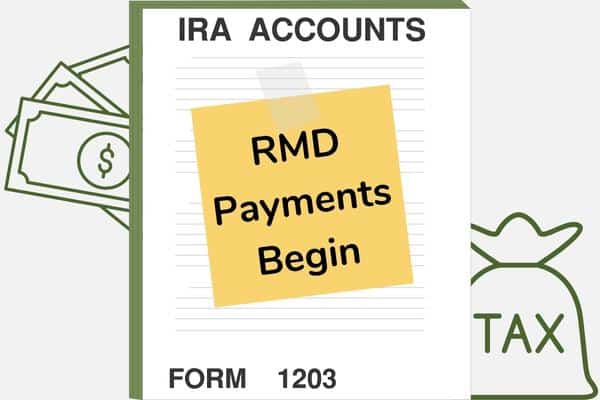Required Minimum Distributions (RMDs) are essential and mandatory financial requirements for those age 73, and individuals who own any inherited IRA accounts. Understanding RMDs will help avoid penalties and optimize your distributions for tax purposes.
What Are RMDs?
RMD stands for Required Minimum Distribution. This is the annual amount that eligible individuals must withdraw from each of their qualified retirement accounts.
Who Must Take RMDs?
Most people must take an RMD from their qualified retirement accounts once they turn 73, and every year thereafter. In some cases, you can delay RMDs until after you retire. You can also defer your initial RMD until April 1st of the following year.
Additionally, there are special requirements if you inherit a retirement account, depending on your relationship to the original account holder, the decedent’s date of death, the type of retirement account, and more.
Why Must I Take an RMD?
Contributions to tax deferred qualified retirement accounts allow you to defer taxes on that portion of your income and savings until retirement age. An RMD acts to ensure that you eventually pay taxes on your prior year earnings. RMDs spread the balance of your qualified retirement account across your lifetime, ensuring that you enjoy the wealth you’ve accumulated, rather than leave it as a legacy.
Note: RMDs from inherited IRAs can be more accelerated, depending upon the year in which the owner died.
Which Retirement Accounts Require RMDs?
The following accounts are subject to RMD rules:
- Traditional IRAs
- Simplified Employee Pension IRAs (SEPs)
- SIMPLE IRAs
- Qualified pension plans
- Qualified stock bonus plans
- Qualified profit-sharing plans (including 401(k) plans)
- Section 457(b) and Section 403(b) plans
- Inherited IRAs (generally, but with some exceptions)
Your plan administrator or tax professional can advise whether RMD rules apply to your employer-sponsored plan.
You don’t need to take RMDs from Roth IRA(s) during your lifetime, but your beneficiaries may have to take distributions.
RMDs are calculated per account but can be withdrawn as an aggregate from only one account if you wish.
Calculating Your RMD
For most taxpayers, the RMD calculation is fairly simple. You divide your account balance on December 31 of the previous calendar year by your distribution factor based upon your age.
If you are the original account owner and your sole beneficiary is a spouse who’s more than 10 years younger than you, you may base your RMD on joint and survivor life expectancy, which affords a longer payout period.
Are RMDs Taxable?
RMDs produce taxable income which is taxed as ordinary income. That said, any after-tax contributions you made may not be subject to tax, simply because those dollars were already taxed.
Can I Withdraw More than My RMD?
You can withdraw more than your RMD, but higher withdrawals deplete your retirement nest egg more quickly and may increase your tax burden.
What If I Don’t Take My RMD?
Failing to take your full RMD, or taking it late, triggers a tax penalty.
When Must I Take My RMD?
Generally, all RMDs must be taken by December 31 of each calendar year, until your balance reaches zero or upon your death.
One exception to this rule applies to your first RMD for an account of your own (not an inherited IRA). In the case of your first RMD only, you can:
- Take the distribution in the year in which RMD rules first apply to you.
- Delay it, taking it no later than April 1 of the year following. This is your ‘Required Beginning Date.’
Should I Delay My First RMD?
If you delay your first RMD if you are age 73 or older, you’ll have to take two distributions in one year: your first year’s deferred RMD (by April 1), plus your second year’s RMD (by December 31). A ‘double distribution’ increases your annual taxable income. Hence, the decision to delay a first year RMD is heavily dependent upon tax planning.
RMDs and Annuities
Purchasing an annuity contract with qualified retirement assets may satisfy RMD requirements if ALL of the following are true:
- Payments are made at least yearly.
- You purchase the annuity on or before the date that your RMDs should begin.
- The annuity is calculated and paid during a time period equal or less than that of the RMD rules.
- Payments, with certain exceptions, are non-increasing.
The decision to purchase an annuity should consider inherent fees, long-term financial impacts relative to both income, growth, inflation, and taxation.
Gifting of RMDs
If you’re age 73 or older and financially secure enough that you don’t need your RMD income, you might wish to consider gifting some or all of your RMD to charities. Such gifts are known as Qualified Charitable Distributions (QCDs). QCDs reduce the amount of taxable income you must report.
Inherited IRAs
The RMD rules for inherited IRAs changed as of December 31, 2019. For all inherited IRAs received as a result of death prior to December 31, 2019, the beneficiary of such inherited IRA is required to take minimum distributions over his or her lifetime, using an actuarial table specified by the IRS. These older rules allow the beneficiary to ‘stretch’ inherited IRA monies over his or her lifetime.
As a result of the SECURE Act, the rules are much different now for inherited IRAs received from a decedent who died on January 1, 2020, or later. Assets received in an inherited IRA must now be completely distributed by the end of the 10th year after the IRA owner’s death. Furthermore, if the decedent was required to take RMDs prior to death, RMDs are required post death as well. Such RMDs must be taken annually, but the RMDs will not fully deplete the account over a 10-year period. Hence, elective withdrawals are required either incrementally over the 10-year window or in a lump sum in that timeframe to fully distribute the account within the mandatory 10-year timeframe.
Please note that there are notable exceptions to the 10-year rule:
- The 10-year distribution rule does not apply to a spouse named as the beneficiary of an IRA.
- Distributions may still be ‘stretched’ over the life or life expectancy of a non-spouse beneficiary if the individual is a minor, disabled, chronically ill or not more than 10 years younger than the deceased IRA owner. This exception only applies to minors until they reach the age of majority, at which time the 10-year rule applies going forward.
As with all aspects of your wealth management, careful planning and knowledgeable guidance is essential to optimize RMDs. As a top-ranked, fee-only financial advisor, SageVest Wealth Management can develop a tax-efficient plan for your Required Minimum Distributions, including evaluating your options for deferring your first RMD, calculating your aggregate RMDs, and facilitating payments. Please contact us for more information about our retirement planning services.




